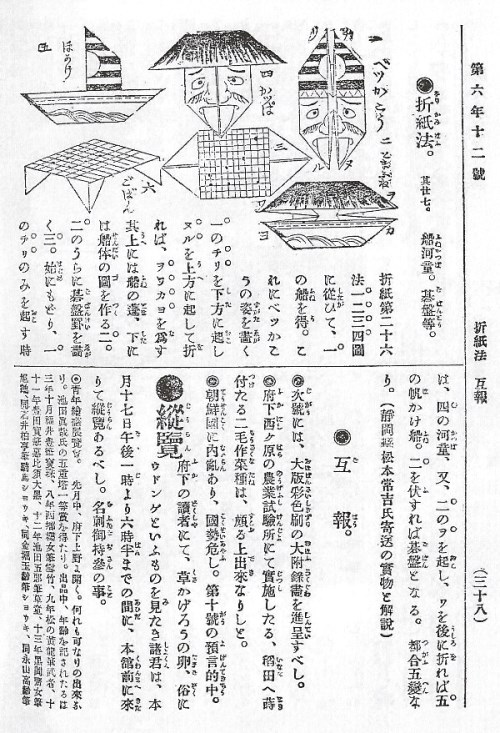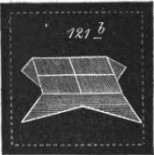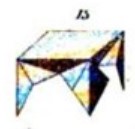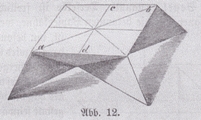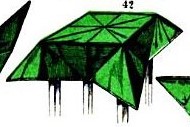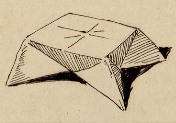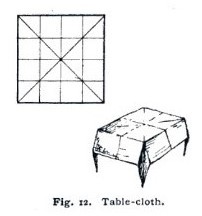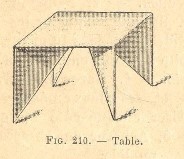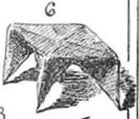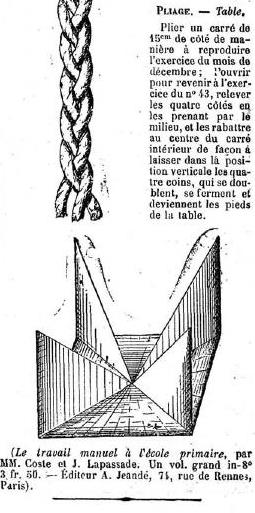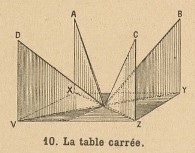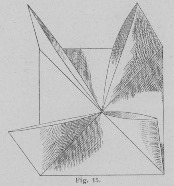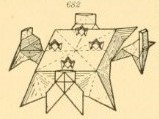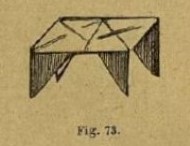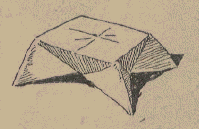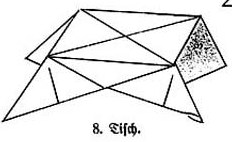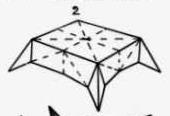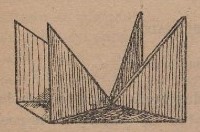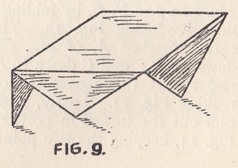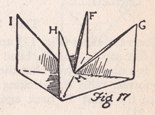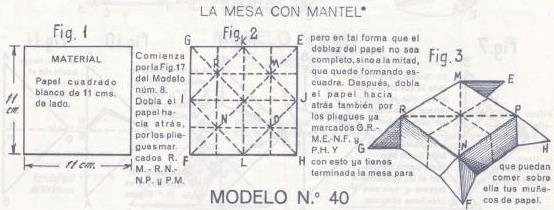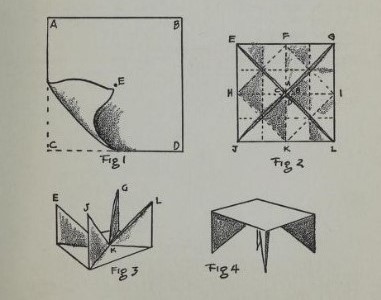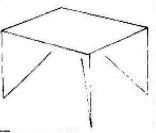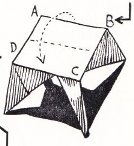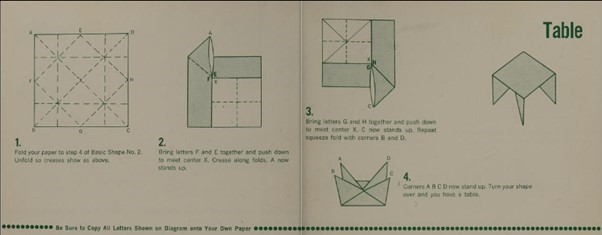| The Public Paperfolding History Project
Last updated 10/12//2025 x |
|||||||
| The Table and the Tablecloth | |||||||
| This
page is being used to collect information about the
history of the closely related paperfolding designs known
as the Table and the Tablecloth. Please contact me if you
know any of this information is incorrect or if you have
any other information that should be added. Thank you. In Japan (and in publications by Japanese authors) 1894 The Table appears in 1894 in issue 12 of the Japanese children's magazine 'Shokokumin', where it is interpreted as a 'Goban' (Go Board) and decorated appropriately. The illustration of this design appears to have been badly drawn. Note that if this design is made from the same sheet of paper as the other designs the table's legs will not be white but will show parts of the other patterns.
********** In Europe and the Americas 1848 'Die Kindergärten' by Wilhelm Middendorf was published by Verlagsbuchhandlung der Kindheit und Jugendbeschäftigungsanstadt in Blankenberg and Rudolfstadt in 1848. It contains a description of children folding Lebensformen which mentions a 'Tisch' which, in the context can be identified as The Table. ********** 1859 A design titled 'La table' appears in a list of designs in the 'Manuel Pratique de Jardins D'Enfants de Friedrich Froebel, which was compiled by J F Jacobs and published in Brussells and Paris in 1859. ********** 1861 A design titled 'ein Tisch' (a table) appears in a list of designs in 'Das Paradies der Kindheit' (The Paradise of Childhood) by Lina Morgenstern, which was published in Leipzig in 1861. There are no accompanying illustrations. ********** 1863 The earliest known illustration of this design is found, as 'De tafel' (the table) in 'De Kleine Papierwerkers 1: Wat men van een stukje papier al maken kan: Het vouwen' (The Small Paperwork 1: What one can make from a piece of paper: Folding) by Elise Van Calcar, which was published by K H Schadd in Amsterdam in 1863.
********** 1869 A design called 'Einen Tisch', which is not illustrated, but which from the context is most probably the Table, appears in a list of designs in 'Der Kindergarten' by Hermann Goldammer, which was published by Habel in Berlin in 1869. ********** 'Paradise of Childhood' by Edward Wiebe, which was published by Milton, Bradley and Company in Springfield, Massachusetts in 1869, and is effectively a translation of Goldammer's 'Der Kindergarten', similarly includes a 'table' in its list of Forms of Life. ********** 1873 There is reference to 'La table' in a list of designs in 'Exercices et Travaux pour les Enfants Selon la Méthode et les Procédés de Pestalozzi et de Froebel' by Fanny and Charles Delon, which was published by Librairie Hachette in Paris in 1873. Unfortunately there is no illustration to confirm the identification of the design. ********** A description of how to alter the Windmill to create 'Der Tisch', but no illustration, appears in 'Die Praxis Des Kindergartens' by August Koehler, which was published by Herman Bohlau in Weimar in 1873. ********** As far as I know the design first appears in its guise as a tablecloth as 'Tisch and Tischtuch' (Table and Tablecloth) in 'Bilder aus dem Kindergarten fur Mutter und Erzhieherrinen' by Ernst Barth, which was published in Leipzig in 1873.
********** 1875 As 'De tafel' in 'Froebels Methode' by Elise Van Calcar, which was published in 1875.
********** 1875 In the second edition of 'Praktischer Wegweiser fur den Unterricht in der Elementarklasse' (Practical Guide for Teaching in the Elementary Class) by Anton Fruhwirth, Alois Fellner and Georg Ernst which was first published by A Pichler's Witwe & Sohn in Vienna in 1875, the text says: 'The unfolded parts can now lie in the plane of the square (ie completely unfolded) or have an inclination towards it. The square is placed on the triangles that have been opened upright (Table with tablecloth) ...'. ********** 1876 The Table also appears in 'Des Kindes Erste Beschaftigungsbuch' by E Barth and W Niederley, which was first published in Bielefeld and Leipzig, and the foreword of which is dated October 1876.
********** 1877 The Table is mentioned, but not illustrated, in 'Kindergarten Practice' by Mary Gurney, which is a substantially abridged version, in two parts, of 'Die Praxis Des Kindergartens' by Auguste Koehler. The second part, 'Froebel's Plane Surfaces', contains sections dealing with paper folding, cutting and weaving. The date of the first edition is not known. The second edition was published in 1877 in London by A N Myers and Co. ********** The design also appears, under the name 'Tisch' (table) in part 2 'Die Praxis' of 'Theoretisches und praktisches Handbuch der Fröbelschen Erziehungslehre' by Bertha von Marentholtz-Bülow, which was published by George H Wigand in Kassel in 1887.
********** 1880 There is mention of a design called 'The Tablecloth' in 'The Kindergarten Principle' by Mary J Lyschinska, which was published in London in 1880 by Wm Isbister Ltd, but no illustration is given. ********** 1882 An illustration of the Tablecloth appears in part two of 'The Kindergarten Guide' by Maria Kraus Boelte and John Kraus, which was probably first published in 1882 by E. Steiger and Company in New York.
********** 1883 A drawing of the Table appears in a pictorial story by Apeles Mestres dated 2nd August 1883 found in his Llibre Vert III.
********** 1885 In an article in The Sydney Mail of 25th July 1885.
********** 1887 As 'Table en papier / La petite table' in 'Cours de Travail Manuel (Pour les Garcons) - Premiere Partie - Cours Elementaire' by A Planty, which was published by Gedalge Jeune in Paris in 1887. It is pictured upside down in order to better explain how to fold the windmill and the windmill base
********** As 'Table' in 'Le Travail Manuel a L'ecole Primaire' by M. Coste et J. Lapassade, which was published by Lafon, Vve Ribaut et Tonnet in Pau and A Jeande in Paris in 1887.
********** 1890 Diagrams for 'Une table a quatre pieds' appear in 'Les travaux manuels a l'ecole primaire a l'usage des ecoles de garcons' by Dauzat and Deramond, which was published by Alcide, Picard et Kaan in Paris in 1890.
********** As 'Table simple' in 'Le travail manuel a l'ecole et dans la famille' by MM, Bertrand, Toussaint and Gombert, which was published by Loucene, Oudin et ces Editeurs in Paris in 1890.
********** 1891 'Pleasant Work for Busy Fingers' by Maggie Browne, which was published by Cassell and Company in London in 1891. This book is an English version of 'Des Kindes Erste Beschaftigungsbuch' enhanced by the addition of a few extra designs. ********** 1892 'The Prang Primary Course in Art Education: Part 1: The First Primary Year' by Mary Dana Hicks and Josephine C Locke, which was published by the Prang Educational Company in Boston in 1892.
********** 1893 In 'L'Annee Preparatoire de Travail Manuel' by M P Martin, which was published by Armand Collin & Cie in Paris in 1893.
********** As 'La mesa' in 'Cuestiones de Pedagogía Práctica: Medios de Instruir' by D Vicente Castro Legua, which was published by Libreria de la Viuda de la Hernando y Ca in Madrid in 1893
********** The Table appears, upside down, in the 15th January 1893 issue of 'Journal des Instituteurs'. This is extracted from the book 'Le Travail Manuel a L'ecole Primaire, by M. Coste et J. Lapassade, which had been published in 1887.
********** 1895 As 'La table carre' in 'L'enseignement manuel dans les ecoles du degre primaire (garcons)' by Rene Leblanc, which was published by Librairie Larousse in Paris in 1895.
********** In 'Geometrie, Dessin et Travaux Manuels - Cours Moyen', produced under the direction of M E. Cazes, which was published by Librairie Ch. Delagrave in Paris in 1895, where it is not named but treated as a base from which rosettes can be developed.
********** 1897 Lois Bates' 'Kindergarten Guide', which was first published by Longmans, Green and Co in London in 1897.
********** In 'Introduccion a la Ensenaza Practica del Sistema de Kindergarten' by Ernesto Steiger, which was published by E Steiger and Co in New York in 1900.
********** 1902 As 'Mesa' in 'Guia Practica del Trabajo Manual Educativo' by Ezequiel Solana, which was published by Editorial Magisterio Español in Madrid in 1902.
********** 1903 In 'La Ensenanza del Trabajo Manuel' by Pedro de Alcántara García and Teodosio Leal y Quiroga, which was published in Madrid in 1903, where it is pictured upside down.
********** 1907 As both 'mesa' (table) and 'mesita' (small table) in an article titled 'El trabajo manual escolar' by Vicente Casto Legua in the January 1907 issue of the Spanish magazine 'La Escuela Moderna' which was published in Madrid by Los Sucesores de Hernando.
********** 1908 In the last ever issue of the Catalan satirical magazine 'La Campana Catalana', published in Barcelona on 29th April 1908, in a cartoon by Apeles Mestres which pictures a variety of paperfolding designs. This pictorial story had previously been published in his Llibre Vert III in 1883.
********** 1910 As 'Tisch' in Part 2 'Das Flechten' of 'Die Frobelschen Beschaftigungen' by Marie Muller-Wunderlich, which was published by Friedrich Brandstetter in Leipzig in 1910.
********** As 'Tisch' in 'Allerlei Papierarbeiten' by Hildergard Gierke and Alice Kuczynski, which was published by Drud und Verlag B G Teubner in Leipzig and Berlin in 1910.
********** As 'Tablecloth' in 'Educational Handwork' by T B Kidner, which was published by The Educational Book Company Limited in Toronto in 1910.
********** As 'A Table' in 'Handicraft in the School', which was issued in four volumes by Gresham Publishing in London in 1910.
********** 1914 As 'La mesa' in 'El Trabajo Manual en la Escuela' by Félix Martí Alpera, which was published by Libreria de los Sucesores de Hernando in Madrid in 1914.
********** 1918 As 'Mesa' in 'Ciencia Recreativa' by Jose Estralella, which was published by Gustavo Gili in Barcelona in 1918. No illustration provided.
********** 1923 As 'Dolls Table' in 'More Paper Magic' by Will Blyth, which was published by C Arthur Pearson in London in 1923.
********** 1928 'Fun with Paperfolding' by William D Murray and Francis J Rigney, which was published by the Fleming H Revell Company, New York in 1928, contains a version of the Table folded from a blintzed windmill base.
********** c1929 As 'Mesa' in booklet 2 of 'Trabajos Manuales Salvatella - Plegado de figuras de papel', which was published by Editorial Miguel A Salvatera in Barcelona, pobably in or around 1929.
********** 1931 As 'Ein Tisch' in the revised 3rd edition of 'Lustiges Papierfaltbüchlein' by Johanna Huber, which was published by Otto Maier in Ravensburg, Germany in 1931.
********** 1936 'Allerlei Papierarbeiten' by Hilde Wulff and Carola Babick, which was published in Leipzig and Berlin in 1936. The design is mentioned in the text as 'Tisch' but not illustrated ********** 1939 As 'Mesa de cuatro puntas' in 'Trabajo Manual Educativo' by Araminta V Aramburu, which was published by F Crespillo in Buenos Aires in 1939.
The Tablecloth design appears (upside down) as 'Bandeja' (tray) in the same work.
********** As 'Mesa' in 'Plegado' by Rufino Yapur, which was published by Editores Independencia in Buenos Aires in 1939.
********** In 'El Mundo de Papel' by Dr Nemesio Montero, which was published by G Miranda in Edicions Infancia in Valladolid in 1939.
********** As 'A Card Table' in 'Fun with Paper' by Joseph Leeming, which was published by Spencer Press Inc in Chicago in 1939.
********** 1940 'El Plegado y Cartonaje en la Escuela Primaria' by Antonio M Luchia and Corina Luciani de Luchia, which was published by Editorial Kapelusz in Buenos Aires in 1940, as 'Mesa Mantel de Cuatro Puntas (Tablecloth with Four Corners).
The same book contains the Tablecloth again, but this time developed from a blintzed windmill base, under the title 'Mesa Cuadrado Doble', as a design from which other blintzed windmill base designs can be developed. ********** 1951 The Tablecloth appears as 'Martel de cuatro puntas' in Plegado laminas published by Della Penna, April 1951. The legs in the illustration do not form part of the design.
********** 1952 As 'Mesa Sencilla' in 'Una Hoja de Papel' by Lorenzo Herrero, which was published by Miguel A Salvatella in Barcelona in 1952.
********** 1956 As 'The Table' in 'Paper Magic' by Robert Harbin, which was published by Oldbourne in London in 1956, as part of the 'Multiform' sequence.
********** 1960 As 'Table' in 'Origami: The Oriental Art of Paper Folding' by Harry C Helfman, which was published by Platt and Munk Co Inc in New York in 1960.
********** 1961 As 'Tischtuch' in 'Wir Falten' by Joachim Schönherr and Gerta Schumann, which was published by Rudolf Arnold Verlag in Leipzig in 1961. ********** |
|||||||
